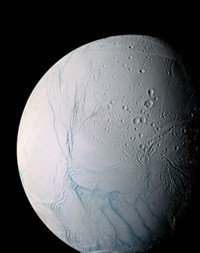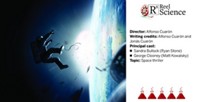Advertisement
Grab your lab coat. Let's get started
Welcome!
Welcome!
Create an account below to get 6 C&EN articles per month, receive newsletters and more - all free.
It seems this is your first time logging in online. Please enter the following information to continue.
As an ACS member you automatically get access to this site. All we need is few more details to create your reading experience.
Not you? Sign in with a different account.
Not you? Sign in with a different account.
ERROR 1
ERROR 1
ERROR 2
ERROR 2
ERROR 2
ERROR 2
ERROR 2
Password and Confirm password must match.
If you have an ACS member number, please enter it here so we can link this account to your membership. (optional)
ERROR 2
ACS values your privacy. By submitting your information, you are gaining access to C&EN and subscribing to our weekly newsletter. We use the information you provide to make your reading experience better, and we will never sell your data to third party members.
Environment
Space Suit In A Cave
Austrian Alps provide a proxy for martian caves that could hold life
by Sarah Everts
May 14, 2012
| A version of this story appeared in
Volume 90, Issue 20
On April 28, as an unseasonably hot sun melted 8-foot-high chunks of winter snow in the Austrian Alps, a man in a space suit waited near the entrance of a cave.
Most visitors to the million-year-old Dachstein Giant Ice Cave prefer to wear standard winter coats during visits to its freezing, icy interior. But for five days the Dachstein cave system was a temporary lab for a squad of space scientists. Some 50 scientists assembled from three continents to use the UNESCO World Heritage site as a proxy for Mars—a first for the cave system, which normally hosts jazz concerts, modern art exhibits, laser shows, and a steady stream of tourists.
The space scientists used the Dachstein caves to practice 12 experiments that they hope to perform on future missions to the Red Planet. Those missions include ExoMars, an unmanned mission planned for 2018 by the U.S. National Aeronautics & Space Administration and the European Space Agency (ESA) as well as a potential human mission that ESA has predicted will take place by 2030. Space scientists typically travel to remote deserts to simulate Mars’s dusty, arid environment, or they go to Antarctica as a proxy for the planet’s frigid temperature, which averages around –35 °C but can range from 30 to –140 °C. While these locations are excellent mimics of the Mars surface, astrobiologists searching for life have their eyes on the Red Planet’s caves, which is where the Dachstein caves come in.
“If there is life on Mars—and it’s a big if—then it would likely be in the planet’s lava canals,” a network of underground caves in the planet’s basalt interior forged by lava during ancient volcanic eruptions, says Gernot Grömer, president of the Austrian Space Forum (ASF), the agency spearheading the field experiments at the Dachstein caves. Martian caves offer the best chance for life because they have a relatively stable temperature between –30 and –40 °C and they contain water—albeit in frozen form, Grömer explains. These underground passageways also offer protection from harmful ultraviolet radiation and solar flares that inundate the planet’s surface—protection that would probably be a prerequisite for life, says Bernard Foing, a space scientist at Free University of Amsterdam and with ESA. “If we want to go to the deepest caves in Mars, then we need to have some operational experience. This is the first time space scientists have tried simulating a Mars operation in a cave,” Grömer says.
The man in the shiny aluminum-coated suit at the cave entrance was 28-year-old Daniel Schildhammer, a physicist who works at ASF. His outfit is called Aouda.X, an approximately $2 million Mars mission space suit simulator made primarily of Panox and Kevlar. Aouda.X has been under development by ASF researchers for the past four years.
It’s called a simulator because the Aouda.X suit is not capable of protecting astronauts in space—at least not yet, says Grömer. For example, it doesn’t have a so-called pressure bladder, the air-tight barrier between the low-pressure Mars atmosphere that would boil an exposed astronaut’s blood and Earth’s atmospheric air pressure required to keep astronauts safe inside the suit.
What the Aouda.X suit does have is an advanced human-machine biomonitoring interface, which provides real-time information pertaining to the astronaut’s health. Information such as heart rate, body temperature, and CO2 and O2 levels are projected to a video screen in the helmet’s visor as well as being sent to mission control. The human-machine interface is “far more advanced than what is currently in space operations,” and it—or something like it—would be necessary for a Mars mission, Grömer says. “Because of the long distance to Mars, there’s a time delay of 26 minutes back to Earth in the worst-case scenario. That means when the astronaut says ‘Houston, we have a problem,’ ” it can take nearly an hour for mission control on Earth to respond, he explains. A Mars astronaut would need to have more real-time information about his or her health and to have more control over the space suit than in current versions, Grömer says.
The Aouda.X also has the overall frame and the 45-kg weight of a space suit so that space scientists can simulate and problem solve the difficulties of doing careful scientific experiments in the Mars caves given the nearly nonexistent dexterity offered by a space suit.
The Aouda.X suit “shows a great deal of potential” and has “revolutionary concepts,” comments Pablo de León, a space scientist at the University of North Dakota. De León is working on two different space suit prototypes, called NDX-1 and NDX-2, that are funded by NASA as potential options for Mars or other planetary missions. In particular, de León’s NDX suits have a sophisticated pressurized layer, an important component currently missing from Aouda.X. “A possible collaboration between the Aouda.X and NDX research teams is in the works,” de León says. Grömer and de León are old friends who studied together at the International Space University in Houston in 1997.
In addition to the Aouda.X and NDX suits, two other space suit prototypes have been under development with a human Mars mission in mind, Grömer says. One, NASA’s Constellation suit, which has exchangeable components such as arms and legs to fit many body sizes, had its funding slashed last year during NASA’s budget cuts. The other, a prototype developed by the Man Vehicle Laboratory at Massachusetts Institute of Technology, focuses on improving the poor ergonomics of current suits.
The Aouda.X suit’s intelligent interior required weeks of training to learn how to operate, Schildhammer told the dozens of journalists who swarmed around him at the cave’s entrance on April 28, rapidly firing questions. “I’m excited,” he answered. “I feel fine in the suit, but my day’s work has only just begun.”
“He’s going to get hot,” predicted Norbert Frischauf, an engineer at ASF, who has tried on the suit previously and who was watching from the sidelines. For example, just walking around in the 45-kg suit for four hours is an exhausting workout that burns approximately 3,000 calories, Frischauf explained. “If you want to lose weight, go to Mars,” he quipped.
Schildhammer’s mission that day was to walk deep into the cave while maintaining contact with scientists just outside the cave as well as scientists in New Zealand and the U.S. He also was supposed to collect a rock sample and carefully stick it into a plastic bag. The seemingly simple tasks are tricky in a suit where it is difficult to bend forward and to turn, Frischauf said. “If you are traveling down a slope, it’s also really hard to see anything in front of you,” he added. “And you don’t want to fall. Mars has one-third of Earth’s gravity, not one-sixth like the moon. If you fall, you can hurt yourself.”
Schildhammer entered the cave, followed by two technicians and the gaggle of journalists. His progress was slow, with periodic stops to rest, recharge batteries, fix dislodged earphones, and eventually practice the sample collection.
The suit’s three-layered glove system made fine-motor control difficult, which will be a challenge when taking martian ice and rock samples that will be evaluated for possible extraterrestrial microbial DNA using the polymerase chain reaction, says Luísa Rodrigues, a microbiologist at the University of Aveiro, in Portugal, and Free University of Amsterdam. One of the biggest concerns for Mars missions, especially a potential human one, is that astronauts might contaminate the planet with some of the trillions of microbes that live in and around humans—or more likely from resilient bacterial endospores traveling along with the space suits from Earth. Besides corrupting experiments to check for life on Mars, humans could also permanently inoculate our neighboring planet with our own life-forms, Foing explains. Foing and Rodrigues were at the Dachstein simulation to develop protocols that minimize microbial contamination during sample collections.
Foing is also working with Balwant Rai and Jasdeep Kaur, who are researchers at Free University of Amsterdam, to develop a small chip, about the length and width of a matchstick but much flatter, which astronauts will keep in their mouths while exploring Mars’s surface. The chip would monitor a wide range of saliva biomarkers that report on a range of medical conditions such as stress, hunger, tooth decay, and even the onset of kidney stone production. Then the chip would send the information wirelessly to the astronaut’s Aouda.X suit, Rai says.
The five-day-long field experiments in the Dachstein caves also included experiments on rovers and other space-related technology. For example, as Schildhammer maneuvered by in the space suit, Stephen Clifford was in the Dachstein ice cave testing a rover called WISDOM (Water Ice & Subsurface Deposit Observation on Mars), which will use radar to map underground water deposits during the planned ExoMars mission.
As the scientists tried to ignore the perfect spring weather outside so they could focus on conducting research inside the frigid Dachstein caves, plans for the Aouda.X space suit’s next practice mission were already afoot. The prototype suit will be tested in Morocco’s Sahara desert in early 2013.
But while researchers continue to improve space suits aimed for a potential human mission to Mars, the biggest hurdle for sending a person to the Red Planet may not be technology, but political will. “It is not a financial issue,” de León says. “We have spent many times more money on other things that bring way less benefit than a mission to Mars will. We humans could be by now a multiplanetary species. But try telling that to the politicians.” Perhaps that will change in 2030.





Join the conversation
Contact the reporter
Submit a Letter to the Editor for publication
Engage with us on Twitter